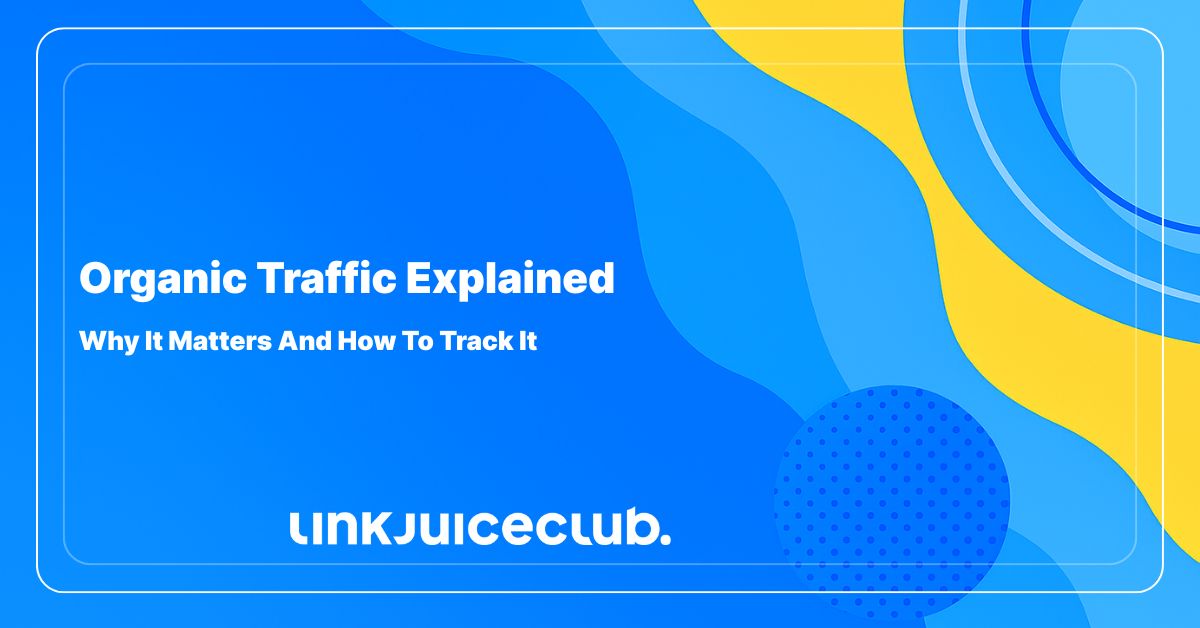
Organic Traffic Explained: Why It Matters And How To Track It
Organic traffic is one of the clearest signals that your SEO is working. It shows that people are finding your site through search engines without the push of paid ads.
This type of traffic matters because it connects you with users actively looking for products, services, or information like yours. More importantly, it builds long-term visibility and growth that doesn’t disappear when a budget runs out.

Understanding Organic Traffic
Organic traffic refers to visits that arrive at your site from unpaid search results. In other words, these are clicks earned naturally from Google, Bing, or other search engines rather than through ads. While you don’t pay for each visit, you do invest in the content, technical SEO, and optimization that make visibility possible.
For many businesses, growing organic traffic is a core SEO objective because it translates into qualified visitors, more leads, and ultimately more sales. Unlike paid campaigns, the value compounds over time, making it a foundation for sustainable growth.
The Upside Of Organic Visitors
Organic traffic delivers several advantages that make it one of the most valuable acquisition channels:
Cost Efficiency Over Time
Organic clicks don’t carry a direct fee like pay-per-click ads. Once your content ranks, visitors arrive at no extra cost, creating long-term ROI.
Relevance And Targeting
Search-driven visits are often highly qualified. Users are actively looking for products, services, or information you provide, which increases the chances of engagement.
Stronger Relationships
Content found organically builds trust. If visitors enjoy their first experience, they’re more likely to return, subscribe, or interact with your brand again.
Sustainable Flow Of Traffic
Unlike paid campaigns that vanish once budgets run dry, organic visibility can deliver consistent results for months or even years if content remains optimized.
Room To Scale
With a structured SEO strategy — keyword targeting, content expansion, and link building — organic performance can grow steadily, driving compounding returns.
The Challenges Of Relying On Organic
While powerful, organic traffic also comes with a few hurdles:
Continuous Investment Required
Although clicks are free, achieving them takes resources. Content creation, SEO audits, and optimization all require time and money.
Slow Ramp-Up
Building rankings doesn’t happen overnight. It often takes months of consistent effort before you see meaningful results.
Algorithm Risk
Search engines update their algorithms frequently. A single update can impact rankings, making it important to adapt strategies regularly.
Comparing Organic And Paid Traffic
Both organic and paid traffic play roles in digital strategy, but they work differently.
Organic Search Clicks
Visitors arrive by finding your site in unpaid listings. The benefit is long-term visibility without paying per click. The drawback is slower growth and reliance on search engines’ rules.
Paid Search Clicks
Traffic comes through PPC campaigns on results pages. These ads deliver immediate visibility and allow for targeting by audience demographics, location, or behavior. However, results stop the moment you stop funding campaigns — and costs can escalate in competitive markets.
For sustainable growth, many businesses balance both: paid for immediate results, organic for long-term authority.
Checking Your Organic Traffic
Knowing how many visitors arrive via search engines is crucial. Here are the key tools and methods to track performance:
Using Organic Research Tools
Platforms like Semrush let you estimate traffic for any domain. Enter a site, review traffic volume, analyze historical growth, and assess how ranking changes influence visits. This gives both a snapshot and long-term trends.
Monitoring In Google Analytics 4
GA4 provides granular reporting:
- Log into GA4.
- Navigate to Reports > Acquisition > Traffic acquisition.
- View “Organic Search” as a channel alongside others.
- Add “Session source” as a secondary dimension to see which search engines drive the traffic.
Analyzing With Google Search Console
GSC focuses specifically on Google organic performance:
- Open Performance > Search results.
- Review total clicks from search.
- Drill down by queries, landing pages, countries, and devices.
This reveals not only how much traffic you receive but also what terms and pages bring the audience in.
Sustaining And Growing Organic Traffic
Tracking numbers is just the beginning. Long-term growth depends on ongoing SEO work.
- Keyword Optimization: Target relevant terms across content and metadata.
- Technical SEO: Improve crawlability, site speed, and indexing.
- Content Creation: Publish helpful, engaging, and updated material regularly.
- Backlink Building: Earn links from credible sites to strengthen authority.
To measure progress, use tools like Position Tracking to monitor keyword rankings. Rising rankings often signal future traffic increases, giving you a leading indicator of growth.
Organic Traffic As A Growth Engine
Focusing on organic visitors is more than chasing numbers. It’s about building a steady presence that keeps working long after a campaign ends. Unlike paid ads that stop when the budget runs dry, organic traffic builds trust, improves visibility, and lowers acquisition costs over time. That’s why many businesses treat it as the backbone of their digital strategy.
Getting there takes patience. Results don’t appear overnight, but consistent effort pays off. With the right tools, ongoing SEO work, and a clear plan, organic traffic turns into a reliable source of growth. The goal is simple: keep attracting visitors who are already looking for what you offer and convert them into long-term customers.





